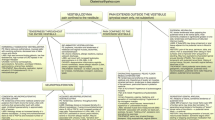Abstract
Purpose of Review
To present a comprehensive systematic approach for diagnosing correctly the cause(s) of bothersome genital symptoms.
Recent Findings
We searched the PUBMED for practical clinical guidelines, written by a multidisciplinary team of healthcare providers directed for diagnosing bothersome genital symptoms. This search was performed by a professional information specialist using the keywords “vulvovaginal,” “vulvar,” “multidisciplinary diagnosis,” “interdisciplinary consultation,” and “vulvology.” We found numerous publications defining the criteria for diagnosing specific disorders, but only a few publications presented a multidisciplinary clinical algorithm for diagnosing bothersome vulvovaginal symptoms. The authors, from three different specialities, gathered together (online), in aim to present a comprehensive systematic approach for accurate diagnosing of bothersome vulvovaginal symptoms.
Summary
Six principles for accurately diagnosing a woman with bothersome genital symptoms were endorsed: (1) locate the discomfort (vulva, clitoris, vestibule, vagina, cervix, pelvis); (2) consider more than one entity; (3) evaluate each symptom separately (it is common to have more than one entity necessitating treatment for each); (4) use pH and wet mount microscopy; (5) obtain a follow-up visit in 2–4 weeks; (6) perform a biopsy for dermatological conditions that are resistant to treatment.




Similar content being viewed by others
References
Kent HL. Epidemiology of vaginitis. Am J Obstet Gynecol. 1991;165(4 pt 2):1168–76.
Anderson MR, Klink K, Cohrssen A. Evaluation of vaginal complaints. JAMA. 2004;291(11):1368–79.
Simonetta C, Burns EK, Guo MA. Vulva dermatoses: a review and update. Mo Med. 2015;112(4):301–7 Review.
Reichman O, Luwisch H, Sela HY, Samueloff A. Genital discomfort: yeast, trichomonas and bacterial vaginosis are only the tip of the iceberg. Eur J Obstet Gynecol Reprod Biol. 2017;214:200–1.
Mills BB. Vaginitis: beyond the basics. Obstet Gynecol Clin N Am. 2017;44(2):159–77.
Anemüller W, Recke A, Altgassen C, Kelling K. Developing an interdisciplinary consultation service for vulvar disorders. J Dtsch Dermatol Ges. 2012;10(5):350–7.
http://vulvovaginaldisorders.com/tutorial/ last entered June 30 2019 .
Dennerstein G, Scurry J, Brenan J, Allen D, Marin MG The vulva and vagina manual, Gynederm Publishing Pty Ltd, 2005.
Blaustein’s pathology of the female genital tract, Robert J. Kurman, Lora Hedrick Ellenson, Brigitte M. Ronnett, Sixth edition.
Buchanan DL, Kurita T, Taylor JA, Lubahn DB, Cunha GR, Cooke PS. Role of stromal and epithelial estrogen receptors in vaginal epithelial proliferation, stratification and cornification. Endocrinology. 1998;139:4345–52.
Mandell: Mandell, Douglas, and Bennett’s principles and practice of infectious diseases, 8th ed. 2015 churchil Livingston.
Reichman O, Sobel JD. Desquamative inflammatory vaginitis. Best Pract Res Clin Obstet Gynaecol. 2014;28(7):1042–50.
Sobel JD, Reichman O, Misra D, Yoo W. Prognosis and treatment of desquamative inflammatory vaginitis. Obstet Gynecol. 2011;117(4):850–5.
Bornstein J, Goldstein AT, Stockdale CK, Bergeron S, Pukall C, Zolnoun D, et al. 2015 ISSVD, ISSWSH and IPPS consensus terminology and classification of persistent vulvar pain and vulvodynia. Obstet Gynecol. 2016;127(4):745–51.
De Andres J, Sanchis-Lopez N, Asensio-Samper JM, Fabregat-Cid G, Villanueva-Perez VL, Monsalve Dolz V, et al. Vulvodynia--an evidence-based literature review and proposed treatment algorithm. Pain Pract. 2016;16(2):204–36.
Falsetta ML, Foster DC, Bonham AD, Phipps R. A review of the available clinical therapies for vulvodynia management and new data implicating proinflammatory mediators in pain elicitation. BJOG. 2017;124(2):210–8.
Sherrard J, Wilson J, Donders G, Mendling W, Jensen JS. 2018 European (IUSTI/WHO) International Union against sexually transmitted infections (IUSTI) World Health Organisation (WHO) guideline on the management of vaginal discharge. Int J STD AIDS. 2018;29(13):1258–72.
Centers for disease and control prevention, https://www.cdc.gov/ last entered June 30 2019.
Acknowledgments
We would like to thank Iris Arad, PhD, Head of Shaare Zedek Medical Center Library, for her help in performing the literature search.
Author information
Authors and Affiliations
Corresponding author
Ethics declarations
Conflict of Interest
All authors have no conflict of interest to disclose.
Human and Animal Rights and Informed Consent
This article does not contain any studies with human or animal subjects performed by any of the authors.
Additional information
Publisher’s Note
Springer Nature remains neutral with regard to jurisdictional claims in published maps and institutional affiliations.
This article is part of the Topical Collection on Female Genital Tract Infections
Rights and permissions
About this article
Cite this article
Reichman, O., Margesson, L.J., Rasmussen, C.A. et al. Algorithms for Managing Vulvovaginal Symptoms—a Practical Primer. Curr Infect Dis Rep 21, 40 (2019). https://doi.org/10.1007/s11908-019-0693-6
Published:
DOI: https://doi.org/10.1007/s11908-019-0693-6




